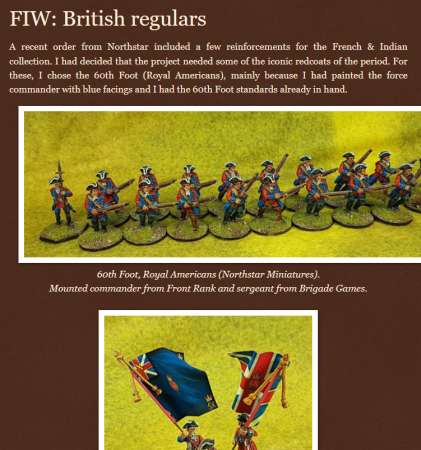
Including the Seven Years' War and the American War of Independence
377 pages. Over 200 full-color plates, four appendices, glossary, index.
The best way to explain this reference book is to indicate how it might be used by a wargamer.
Let's say that you're painting up the 63rd Regiment of Foot for use in a Bunker's Hill scenario for the American War of Independence. You would simply turn to the infantry section of the book, and flip to the entry for the 63rd (they are listed in numerical order, mostly), and there are 16 uniform drawings on a single page (ranging from 1755 to 1785), plus drawings of details such as buttons, grenadier mitre cap, lace, etc.
Since Bunker Hill is 1775, you can ignore the 1780s drawings, which leaves you with 1760s drawings (plus 1771 drawings for the Light Company). Red uniform with white lining and dark green facings, cuffs and collar; white breeches, white waistcoat (red for the Light Company); NCO's sash in red with a green stripe. The only confusion is that the drawings show conflicting shoulder decoration - for instance, two drawings (1769, 1771) show officers with white epaulettes, while one (1768) shows no epaulettes; some privates similarly have red 'wing' decorations.
For further information, you can turn to the text entry for this regiment, which is in the section preceding these color plates. There are again listed in (mostly) numerical order, though the typography makes them harder to search through. In this example, there's about two-thirds of a page of information, listing the regiment's names during this time period, the uniform regulations of 1758 and 1768, and a summary of action in the Revolutionary War. The only new information in this example is that officers' lace is silver; other ranks' lace is white with green edging in the center (which explains lace drawing on the color plate page, though I doubt my painting skills will rise to this level of detail!).
That, then, is what this book is: a uniform reference. The uniform information is broken down by cavalry and infantry, and by royal and non-royal regiments. There is an index to help locate units by name, if you don't know the number.
At the front of the book, there is a general introduction to cavalry and infantry uniforms, also including equipment and weaponry. If you are new to the period, you will find yourself referencing the glossary a lot (and perhaps a dictionary) to find out what some of the terms mean.
There are four appendices. The first, Rank distinctions of Officers and Enlisted men, explains why the drawings from our examples show white epaulettes in some of the officers' uniforms (epaulettes were phasing in around 1768); similarly, the 'wings' were introduced for grenadiers and light infantrymen.
The other appendices show all known facing colors with their Pantone equivalent; a chart showing the lineage of the regiments; and the last discusses the author's sources (the regulations, paintings, other publications).
One negative with this book is that the author, while apparently knowledgeable in his field, is not a skilled writer. His writing is often muddled and contradictory. For example:
It may well be that, over time, shoulder straps were laced, but this may not have been the case.
Reviewed by ![]() Editor in Chief Bill
Editor in Chief Bill ![]()
![]() .
.








